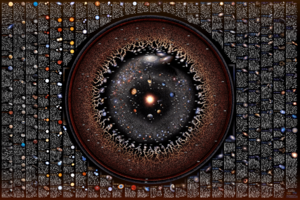Lists of astronomical objects facts for kids
Our universe is a vast and amazing place, filled with countless objects. From tiny dust particles to giant galaxies, everything in space is called an astronomical object. Scientists study these objects to understand how the universe began, how it works, and what its future might be. Let's take a journey through space and explore some of the incredible things we can find!
- Moon Mimas and Ida, an asteroid with its own moon, Dactyl
- Comet Lovejoy and Jupiter, a giant gas planet
- The Sun; Sirius A with Sirius B, a white dwarf; the Crab Nebula, a remnant supernova
- A black hole (artist concept); Vela Pulsar, a rotating neutron star
- M80, a globular cluster, and the Pleiades, an open star cluster
- The Whirlpool galaxy and Abell 2744, a galaxy cluster
- Superclusters, galactic filaments and voids
Contents
Our Cosmic Neighborhood: The Solar System
Our Solar System is our home in space. It includes the Sun, eight planets, and many other smaller objects. Everything in our Solar System orbits the Sun.
Planets and Moons
The most famous objects in our Solar System are the planets. There are eight main planets, like Earth, Mars, and Jupiter. Some planets are rocky, while others are giant balls of gas.
Many planets have their own moons orbiting them. Earth has one moon, but Jupiter has dozens! Scientists have found many different kinds of moons.
Asteroids and Comets
Besides planets and moons, our Solar System has lots of smaller objects. Asteroids are rocky leftovers from when the Solar System formed. Most of them are found in the asteroid belt between Mars and Jupiter. Some asteroids even have their own tiny moons!
Comets are like dirty snowballs made of ice, dust, and rock. When a comet gets close to the Sun, the ice melts and forms a beautiful tail. This tail can stretch for millions of miles.
There are also dwarf planets, which are smaller than regular planets. Pluto is a famous dwarf planet.
Twinkling Giants: Stars
Stars are giant balls of hot, glowing gas. They produce their own light and heat through a process called nuclear fusion. Our Sun is a star, and it's the closest one to Earth.
Different Kinds of Stars
Stars come in many different sizes, colors, and brightnesses. Some stars are much bigger and brighter than our Sun, like supergiants. Others are tiny, like white dwarfs, which are the leftover cores of dead stars.
Some stars are variable stars, meaning their brightness changes over time. When a very massive star dies, it can explode in a huge blast called a supernova. These explosions are incredibly bright and can leave behind fascinating objects like neutron stars or black holes.
Star Groups: Clusters
Stars often live together in groups called star clusters. There are two main types:
- Open clusters are groups of younger stars that are loosely held together. The Pleiades is a famous open cluster you can see in the night sky.
- Globular clusters are much older and contain hundreds of thousands of stars packed tightly together. They are usually found orbiting galaxies.
Cosmic Clouds: Nebulae
Nebulae are giant clouds of dust and gas in space. They are often where new stars are born, or they can be the remains of dead stars. Nebulae come in different types:
- Diffuse nebulae are large, spread-out clouds where stars are forming.
- Planetary nebulae are glowing shells of gas thrown off by dying stars. They look like planets through a telescope, but they are not.
- Dark nebulae are dense clouds that block light from behind them, making them appear dark.
Island Universes: Galaxies
Galaxies are huge collections of stars, gas, dust, and dark matter, all held together by gravity. They are like giant islands in space.
Our Home Galaxy: The Milky Way
Our Solar System is part of a galaxy called the Milky Way. It's a spiral galaxy, which means it has a central bulge and spiral arms, like a giant pinwheel. We can't see the whole shape of the Milky Way from Earth because we are inside one of its arms.
Other Galaxies and Their Groups
There are billions of galaxies in the universe, and they come in different shapes, like spirals, ellipticals, and irregulars. The closest large galaxy to us is the Andromeda Galaxy.
Galaxies are not usually alone. They often group together to form galaxy groups and even larger galaxy clusters. Our Milky Way is part of the Local Group of galaxies.
Mysterious Giants: Black Holes
Black holes are some of the most mysterious objects in space. They are regions where gravity is so strong that nothing, not even light, can escape. Black holes form when very massive stars collapse at the end of their lives.
Scientists have found different sizes of black holes. Some are small, formed from single stars. Others are supermassive black holes that are millions or even billions of times more massive than our Sun. These giant black holes are found at the center of most galaxies, including our own Milky Way.
Beyond Galaxies: Superstructures
On the largest scales, galaxies themselves are not spread out evenly. They form huge networks called galaxy filaments and superclusters, which are like cosmic threads and knots. In between these structures are vast empty spaces called voids. This creates a giant, web-like structure across the universe.
Mapping the Cosmos
Scientists use powerful telescopes and special tools to map the universe. They create astronomical catalogues which are like giant lists of objects. Famous catalogues include the Messier Catalogue and the NGC Catalogue, which list thousands of nebulae, star clusters, and galaxies. These maps help us understand the incredible scale and structure of the universe.
See also
- Lists of astronauts
- List of government space agencies
- List of planetariums
- Lists of space scientists
- Lists of spacecraft


















